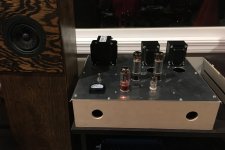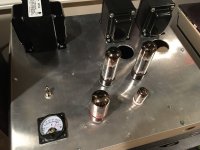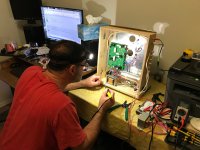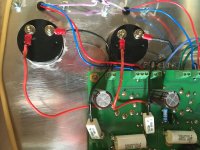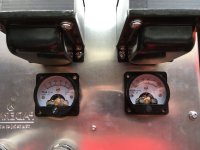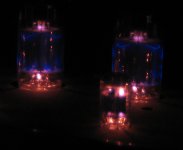Well my anxiety level is lower. 😉
I just did exactly as you wrote, George, and it worked exactly as you said it would.
So, time to try the test with no dim-bulb tester.
I just did exactly as you wrote, George, and it worked exactly as you said it would.
So, time to try the test with no dim-bulb tester.

Frank Morgan - "My Old Flame" playing quite nicely through both speakers.
434V B+ (that's with the 5AR4).
No smoke, just that nice smell of "warm" electronics.
So... next steps to be sure things are stable...?
434V B+ (that's with the 5AR4).
No smoke, just that nice smell of "warm" electronics.
So... next steps to be sure things are stable...?
I do have my auxiliary power supply cap (80uF 470v motor run) that I have never hooked up. All mounted up and grounded, leads soldered and waiting to be connected to the terminals.
Thanks!
What a relief. I think I am still in disbelief right now.
Time for a large glass of wine!
Cheers to everyone who has helped me figure this out, especially George of course!
What a relief. I think I am still in disbelief right now.
Time for a large glass of wine!

Cheers to everyone who has helped me figure this out, especially George of course!
Auxiliary PS cap connected. No issues.
I am really tempted to take the amp into the living room and test it out with some proper speakers.
However, I have decided to go ahead and install my permanent B+ voltmeter... almost done... just waiting for my soldering iron to heat up.
I am really tempted to take the amp into the living room and test it out with some proper speakers.
However, I have decided to go ahead and install my permanent B+ voltmeter... almost done... just waiting for my soldering iron to heat up.
I figure I owe the community a couple of pics. Still a long way to go (install ammeters for each power tube, stain/finish the chassis wood, install Vu meters on front, install bottom grille, install feet, figure out how to polish the top plate...)
But at least it works for now. Nice to have a permanent B+ voltmeter.
But at least it works for now. Nice to have a permanent B+ voltmeter.
Attachments
Okay so enough of the "test tubes".
I popped in a NOS Marconi Canada (Radiotron) 12AT7 (unused and probably from the 50s) and a couple of NIB Reflektor OTK 6P3S-E (1976).
Thought about it for 30 seconds or so and then cued up Dire Straights - "In the Gallery".
The dynamics and detail are ******* excellent. There is something that I can't quite describe about the sound of this amp. It is "immediate" but gone as soon as it arrives. I dunno. The exact opposite of "smeared". Instrument separation is unreal. All of that, with room-filling warmth. I can't really ask for anything more.
I popped in a NOS Marconi Canada (Radiotron) 12AT7 (unused and probably from the 50s) and a couple of NIB Reflektor OTK 6P3S-E (1976).
Thought about it for 30 seconds or so and then cued up Dire Straights - "In the Gallery".
The dynamics and detail are ******* excellent. There is something that I can't quite describe about the sound of this amp. It is "immediate" but gone as soon as it arrives. I dunno. The exact opposite of "smeared". Instrument separation is unreal. All of that, with room-filling warmth. I can't really ask for anything more.
Last edited:
The amp has been playing for quite a long time now. I just used my IR thermometer to check the power transformer. 40C, which is a hell of a lot cooler than the 274BX ran when it worked. It was hot to touch, whereas the 6K7VG is merely warm.
Cogitech,
Congratulations on getting the amp functional again!
The SSE is an excellent sounding amp with the right speakers. By that I mean at least sensitivity of around 88 dB and reasonable impedance load. Single driver, wide-band speakers generally fit the bill, and IIRC you have Mark Audio Alpair 10.x speakers? Should sound very nice with those. 🙂
p.s. I like your choice of test track too, "In The Gallery" by Dire Straits...
Congratulations on getting the amp functional again!
The SSE is an excellent sounding amp with the right speakers. By that I mean at least sensitivity of around 88 dB and reasonable impedance load. Single driver, wide-band speakers generally fit the bill, and IIRC you have Mark Audio Alpair 10.x speakers? Should sound very nice with those. 🙂
p.s. I like your choice of test track too, "In The Gallery" by Dire Straits...
Last edited:
Thanks Zia!
I do have a pair of MarkAudio Alpair 10.2 drivers - but they have been sitting in a cardboard box in the basement, waiting for me to build them a new home... which I have finally decided will be a pair of Scott Lindgren's "Silbury" design. I did try the Alpair 10.2 drivers in Scott's "Pensil" design but they just didn't suit me (or perhaps my room).
The speakers I am running (you can see one in the photo) are dual driver Planet 10 microTowers in the "Castle" configuration (one driver facing forward, and one driver on the top). I chose the CSS EL70 drivers (made by Mark Audio for CSS), which are 86dB drivers but I am quite certain this increases when you put 2 of them in a good enclosure like this. The SSE easily drives them (in triode mode with no feedback) loud enough for me. I have really enjoyed these speakers for quite a few years now. The combination of point-source and omni really works well, IMHO. Similar in concept to Ohm Acoustics "Walsh" and others. All this to say "yes!" the SSE is a great match to my current (and future) speakers.
I don't know why I spelled "Dire Straits" the way I did. It isn't like the band is new to me. 🙂
I do have a pair of MarkAudio Alpair 10.2 drivers - but they have been sitting in a cardboard box in the basement, waiting for me to build them a new home... which I have finally decided will be a pair of Scott Lindgren's "Silbury" design. I did try the Alpair 10.2 drivers in Scott's "Pensil" design but they just didn't suit me (or perhaps my room).
The speakers I am running (you can see one in the photo) are dual driver Planet 10 microTowers in the "Castle" configuration (one driver facing forward, and one driver on the top). I chose the CSS EL70 drivers (made by Mark Audio for CSS), which are 86dB drivers but I am quite certain this increases when you put 2 of them in a good enclosure like this. The SSE easily drives them (in triode mode with no feedback) loud enough for me. I have really enjoyed these speakers for quite a few years now. The combination of point-source and omni really works well, IMHO. Similar in concept to Ohm Acoustics "Walsh" and others. All this to say "yes!" the SSE is a great match to my current (and future) speakers.
I don't know why I spelled "Dire Straits" the way I did. It isn't like the band is new to me. 🙂
Last edited:
These 6P3S-E tubes sound so good I went ahead and bought another pair. The fact that they are literally half the price of a basic modern JJ EL34 or 6L6 or whatever and they have beautiful blue glow are just icing on the cake.
Thanks to w5jag for posting this a few years ago. Installing panel meters on an SE
I followed your instructions and now have my ammeters installed successfully:
I followed your instructions and now have my ammeters installed successfully:
Attachments
Excellent work, cogitech! I'm mighty glad you were able to get it all worked out. A defective transformer is the last thing I would've expected. I've used Hammond transformers for 20+ years now, and as George has noted they run hot for sure, but I've never even heard of an outright failure. The fact that you were able to get a replacement (albeit a bit late) was icing on the cake.
Your choice of Silburys is probably an excellent match for the SSE. I built a pair last year and they sound great with my TES-II (quite smooth and neutral with good bass) but they really need a bit more power to come into their own. One thing I've discovered with back loaded horns in general is that the bass suffers greatly if there are any leaks at all, so don't be squeamish about using a lot of glue and clamps.
Also, if your conversation with Scott was like mine then you'll be planning on building a pair of outriggers to improve lateral stability. But be forewarned, these speakers are heavy - like 100 lb. (45.3 kg) each - and extremely unwieldy to lift. A pair of handles attached to either side would help immensely in this regard. They don't have to be anything fancy; even a couple of 1" x 1" x 4"" (25 x 25 x 100 mm) wooden blocks screwed to the sides will suffice. You'll be glad you did, even if all you do is use them to lift each speaker onto a moving dolly.
At all events I'm glad to see you succeed. I know it's been frustrating at times, but I promise you that you've learned more than you think. Good show!
Your choice of Silburys is probably an excellent match for the SSE. I built a pair last year and they sound great with my TES-II (quite smooth and neutral with good bass) but they really need a bit more power to come into their own. One thing I've discovered with back loaded horns in general is that the bass suffers greatly if there are any leaks at all, so don't be squeamish about using a lot of glue and clamps.
Also, if your conversation with Scott was like mine then you'll be planning on building a pair of outriggers to improve lateral stability. But be forewarned, these speakers are heavy - like 100 lb. (45.3 kg) each - and extremely unwieldy to lift. A pair of handles attached to either side would help immensely in this regard. They don't have to be anything fancy; even a couple of 1" x 1" x 4"" (25 x 25 x 100 mm) wooden blocks screwed to the sides will suffice. You'll be glad you did, even if all you do is use them to lift each speaker onto a moving dolly.
At all events I'm glad to see you succeed. I know it's been frustrating at times, but I promise you that you've learned more than you think. Good show!
Thanks a lot, Mr_Zenith!
Regarding your comment about the Silburys needing a bit more power to come into their own, would an SSE in ultralinear mode with CFB be sufficient, or are you saying the Silburys need more like 20-25watts?
I am not "married" to the idea of the Silburys, but I sure am smitten. I did seriously consider building Scott's "Jaguar" double-mouth MBVR (Moose Big Vent Reflex). I have read that this design makes a shocking amount of bass with a single Alpair 10. Lots of pluses with that one vs. Silbury. Easier build, less material (cheaper), lighter, a foot shorter...
I really have learned a lot during this amp build - and I still have so much to learn. I need to stay focused on finishing it all properly so it doesn't stay in a semi-finished state forever.
Thanks again to everyone for helping me through this. Without this community, and especially George and a few others, I never would have been able to accomplish any of this.
Regarding your comment about the Silburys needing a bit more power to come into their own, would an SSE in ultralinear mode with CFB be sufficient, or are you saying the Silburys need more like 20-25watts?
I am not "married" to the idea of the Silburys, but I sure am smitten. I did seriously consider building Scott's "Jaguar" double-mouth MBVR (Moose Big Vent Reflex). I have read that this design makes a shocking amount of bass with a single Alpair 10. Lots of pluses with that one vs. Silbury. Easier build, less material (cheaper), lighter, a foot shorter...
I really have learned a lot during this amp build - and I still have so much to learn. I need to stay focused on finishing it all properly so it doesn't stay in a semi-finished state forever.
Thanks again to everyone for helping me through this. Without this community, and especially George and a few others, I never would have been able to accomplish any of this.
These 6P3S-E tubes sound so good I went ahead and bought another pair. The fact that they are literally half the price of a basic modern JJ EL34 or 6L6 or whatever and they have beautiful blue glow are just icing on the cake.
Really nice tubes, although on paper they don't gave the same plate dissipation as an EL34, so that's something to watch. They are the tubes in my avatar that I use on other forums.
jeff
Attachments
Last edited:
Hi Jeff,
Thanks for the warning.
I was concerned about the official specs at first - not just the dissipation but the supposed maximum 250v.
I did a whole bunch of reading on guitar amp forums about these tubes. Over and over again I read accounts of people running them well over 400v and dissipating 30 watts or more before red-plating. They always made sure to be clear they were talking about the "-E" version.
All this hardly matters because I am running 680 ohm cathode resistors which limits dissipation to about 21 watts. This also limits my power output a bit, but the system still plays plenty loud and clean enough for me.
Thanks for the warning.
I was concerned about the official specs at first - not just the dissipation but the supposed maximum 250v.
I did a whole bunch of reading on guitar amp forums about these tubes. Over and over again I read accounts of people running them well over 400v and dissipating 30 watts or more before red-plating. They always made sure to be clear they were talking about the "-E" version.
All this hardly matters because I am running 680 ohm cathode resistors which limits dissipation to about 21 watts. This also limits my power output a bit, but the system still plays plenty loud and clean enough for me.
I'm going to leave it in triode mode but hookup CFB and see if I like it better or not. Trying to figure out wiring orientation. I think I have read that the only way to do it is try it both ways and pick the one that is quieter.
Is there a better way to do this?
Is there a better way to do this?
I was curious, so I replaced my 680 ohm cathode resistors with 560 ohm. At first, I saw what I expected. B+ dropped slightly (due to higher load) and power tube amperage climbed to about 63 mA (from about 56 mA). I couldn't really hear a difference, if I am honest. I suspect the extra mA comes into play at higher volumes (?)
However, after a few hours I noticed a few things. 1) B+ seems to be struggling to maintain 410V, 2) tube current has dropped to 58 mA, and 3) the power transformer is about 5-6 Celcius hotter.
So this seems like a balancing act. Drive the power tube current (load) up too much and the power supply struggles enough that B+ drops. The question is, which is better? Higher current at the cost of B+, or drop the current to maintain a good 435-440V B+ ??
I might try 620 ohm cathode resistors and see if I can strike a balance, but I'd like to hear the theory on this.
However, after a few hours I noticed a few things. 1) B+ seems to be struggling to maintain 410V, 2) tube current has dropped to 58 mA, and 3) the power transformer is about 5-6 Celcius hotter.
So this seems like a balancing act. Drive the power tube current (load) up too much and the power supply struggles enough that B+ drops. The question is, which is better? Higher current at the cost of B+, or drop the current to maintain a good 435-440V B+ ??
I might try 620 ohm cathode resistors and see if I can strike a balance, but I'd like to hear the theory on this.
Last edited:
- Home
- More Vendors...
- Tubelab
- Yet Another SSE Build Thread
